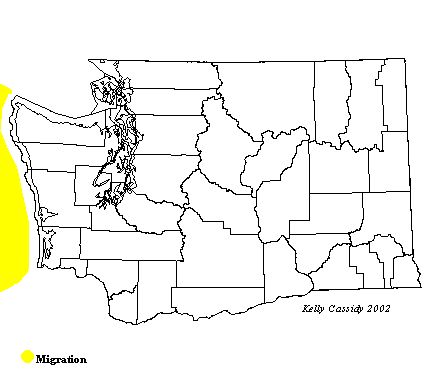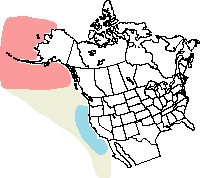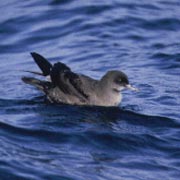Short-tailed Shearwater
General Description
The Short-tailed Shearwater is similar in appearance to the Sooty Shearwater, although its bill is smaller, its head is rounder, and its wings are narrower and more angled. Check a field guide for accurate identification.
Habitat
The breeding habitat of the Short-tailed Shearwater is on islands, and in some cases mainland areas, where grass and shrubs cover soil soft enough to allow the excavation of a burrow. During the non-breeding season, the Short-tailed Shearwater spends its time on the open ocean, concentrating over upwellings at the edge of the continental shelf in cool water.
Behavior
Short-tailed Shearwaters forage mostly by diving from a swimming position on the surface of the water, or by plunging from a few feet above the water's surface. They swim under water by propelling themselves with their wings, and may dive as deep as 60 feet below the surface. They can sometimes be found foraging in association with whales or dolphins.
Diet
Their diet consists of fish, crustaceans, and squid.
Nesting
Short-tailed Shearwaters first breed at 5-8 years of age. Colony nesters, Short-tailed Shearwaters typically locate their colonies on islands off southeastern Australia, but will also use mainland areas. The breeding season is from September to April. They are most active in the colonies at night. Both parents help dig a burrow in the soil. At the end of the burrow is a nest chamber that may be lined with grass. The female lays one egg, and both parents incubate for 7-8 weeks. Both feed the young by regurgitation. After 11-15 weeks, the chick leaves the nesting colony and heads to sea.
Migration Status
During summer in the Northern Hemisphere, Short-tailed Shearwaters can be found as far north as Alaska, the Bering Strait, and beyond. In April and May, they can be found off the Washington coast. In August and September, they can be seen heading south to breed. Non-breeders may stay in the Northern Hemisphere all year.
Conservation Status
The status of the Short-tailed Shearwater is difficult to determine, as it can be difficult to distinguish from the Sooty Shearwater. Total numbers are estimated at more than 20 million.
When and Where to Find in Washington
Where and When to Find in Washington
Reports vary from one year to the next, but Short-tailed Shearwaters are most often seen in the late summer and fall, although they are relatively uncommon. They are very rare in spring and winter. The best way to see Short-tailed Shearwaters is from a boat. During the fall migration or following an onshore storm, they can sometimes be seen in the Strait of Juan de Fuca.
 Abundance
Abundance
| Ecoregion | Jan | Feb | Mar | Apr | May | Jun | Jul | Aug | Sep | Oct | Nov | Dec |
|---|---|---|---|---|---|---|---|---|---|---|---|---|
| Oceanic | U | U | U | R | R | R | R | U | ||||
| Pacific Northwest Coast | R | R | R | R | R | R | R | R | ||||
| Puget Trough | R | R | ||||||||||
| North Cascades | ||||||||||||
| West Cascades | ||||||||||||
| East Cascades | ||||||||||||
| Okanogan | ||||||||||||
| Canadian Rockies | ||||||||||||
| Blue Mountains | ||||||||||||
| Columbia Plateau |
Washington Range Map

North American Range Map


Family Members
 Northern FulmarFulmarus glacialis
Northern FulmarFulmarus glacialis Murphy's PetrelPterodroma ultima
Murphy's PetrelPterodroma ultima Mottled PetrelPterodroma inexpectata
Mottled PetrelPterodroma inexpectata Cook's PetrelPterodroma cookii
Cook's PetrelPterodroma cookii Pink-footed ShearwaterPuffinus creatopus
Pink-footed ShearwaterPuffinus creatopus Flesh-footed ShearwaterPuffinus carneipes
Flesh-footed ShearwaterPuffinus carneipes Greater ShearwaterPuffinus gravis
Greater ShearwaterPuffinus gravis Wedge-tailed ShearwaterPuffinus pacificus
Wedge-tailed ShearwaterPuffinus pacificus Buller's ShearwaterPuffinus bulleri
Buller's ShearwaterPuffinus bulleri Sooty ShearwaterPuffinus griseus
Sooty ShearwaterPuffinus griseus Short-tailed ShearwaterPuffinus tenuirostris
Short-tailed ShearwaterPuffinus tenuirostris Manx ShearwaterPuffinus puffinus
Manx ShearwaterPuffinus puffinus

